Exactly at 12:50 p.m. a 320-ton and 44.4-meter-tall rocket lifted off from the Satish Dhawan Space Centre in Sriharikota in the Indian state of Andhra Pradesh. Just over 20 minutes into the flight, the rocket ejected its sole passenger at an altitude of 488.9 km. Soon after this, the satellite's solar panels were deployed. The satellite is being controlled by the Mission Control Facility (MCF) at Hassan in Karnataka state.
India's Prime Minister Narendra Modi, who watched the launch of the navigation satellite, congratulated scientists at India's ISRO space agency and said the system would make India independent in navigation.
First and foremost I want to congratulate all @isro scientists and the entire team. I also congratulate the people of India: PM
— PMO India (@PMOIndia) 28 апреля 2016 г.
With this successful launch, we will determine our own paths powered by our technology. This is a great gift to people from scientists: PM
— PMO India (@PMOIndia) 28 апреля 2016 г.
The Indian Regional Navigation Satellite System (IRNSS) is similar to America's GPS, Russia's Glonass and Europe's Galileo. Apart from the civilian applications, the IRNSS will also be used to meet defense needs.
The first satellite of the system, IRNSS-1A, was launched in July 2013. Each satellite costs about $22 million and rockets cost around $19 million each. The total project is estimated at around $211 million.



